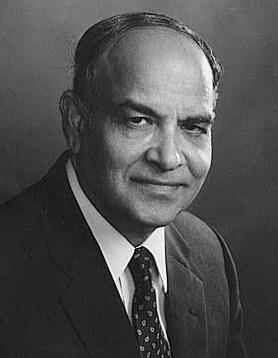Kazi Mobin-Uddin
Kazi Mobin-Uddin was a pioneering figure in the field of medicine, particularly known for his significant contributions to vascular surgery. Born in 1928, he made his mark in medical history through the invention of the inferior vena cava filter, a device designed to prevent pulmonary embolisms. This invention has saved countless lives by catching blood clots before they can reach the lungs, which can be fatal.
Early Life and Education[edit | edit source]
Kazi Mobin-Uddin was born in India and later moved to the United States for his higher education. He pursued his medical degree at the University of Michigan, where he showcased his potential as a future innovator in the medical field. His passion for improving patient care and his interest in vascular diseases led him to specialize in vascular surgery.
Career and Contributions[edit | edit source]
After completing his medical education, Mobin-Uddin dedicated his career to the field of vascular surgery, where he focused on the treatment and prevention of venous thrombosis and pulmonary embolisms. His most notable contribution, the Mobin-Uddin Umbrella, was developed in the late 1960s. This device was one of the first inferior vena cava filters used to prevent pulmonary embolisms by catching emboli in the bloodstream before they could reach the lungs.
The invention of the Mobin-Uddin Umbrella marked a significant advancement in medical technology, offering a new preventive measure for patients at high risk of pulmonary embolism. His work has paved the way for further innovations in the design and application of vena cava filters, making them safer and more effective.
Legacy[edit | edit source]
Kazi Mobin-Uddin's contributions to medicine have left a lasting impact on the field of vascular surgery and patient care. His invention of the inferior vena cava filter has been recognized as a groundbreaking achievement, providing a critical tool in the fight against venous thromboembolism. Mobin-Uddin's dedication to his work and his innovative spirit have inspired many in the medical community to continue exploring new ways to improve patient outcomes.
Throughout his career, Mobin-Uddin received numerous accolades for his contributions to medicine, including recognition from various medical societies and institutions. His work continues to be studied and celebrated by medical professionals around the world, highlighting his enduring legacy in the field of healthcare.
Death[edit | edit source]
Kazi Mobin-Uddin passed away in 1999, leaving behind a legacy of innovation and dedication to improving patient care. His work continues to influence the field of vascular surgery and the development of medical devices.
See Also[edit | edit source]
Search WikiMD
Ad.Tired of being Overweight? Try W8MD's physician weight loss program.
Semaglutide (Ozempic / Wegovy and Tirzepatide (Mounjaro / Zepbound) available.
Advertise on WikiMD
|
WikiMD's Wellness Encyclopedia |
| Let Food Be Thy Medicine Medicine Thy Food - Hippocrates |
Translate this page: - East Asian
中文,
日本,
한국어,
South Asian
हिन्दी,
தமிழ்,
తెలుగు,
Urdu,
ಕನ್ನಡ,
Southeast Asian
Indonesian,
Vietnamese,
Thai,
မြန်မာဘာသာ,
বাংলা
European
español,
Deutsch,
français,
Greek,
português do Brasil,
polski,
română,
русский,
Nederlands,
norsk,
svenska,
suomi,
Italian
Middle Eastern & African
عربى,
Turkish,
Persian,
Hebrew,
Afrikaans,
isiZulu,
Kiswahili,
Other
Bulgarian,
Hungarian,
Czech,
Swedish,
മലയാളം,
मराठी,
ਪੰਜਾਬੀ,
ગુજરાતી,
Portuguese,
Ukrainian
Medical Disclaimer: WikiMD is not a substitute for professional medical advice. The information on WikiMD is provided as an information resource only, may be incorrect, outdated or misleading, and is not to be used or relied on for any diagnostic or treatment purposes. Please consult your health care provider before making any healthcare decisions or for guidance about a specific medical condition. WikiMD expressly disclaims responsibility, and shall have no liability, for any damages, loss, injury, or liability whatsoever suffered as a result of your reliance on the information contained in this site. By visiting this site you agree to the foregoing terms and conditions, which may from time to time be changed or supplemented by WikiMD. If you do not agree to the foregoing terms and conditions, you should not enter or use this site. See full disclaimer.
Credits:Most images are courtesy of Wikimedia commons, and templates Wikipedia, licensed under CC BY SA or similar.
Contributors: Prab R. Tumpati, MD

